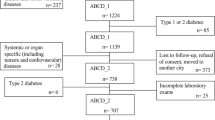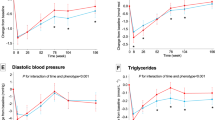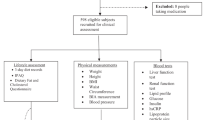Abstract
Objectives:
To investigate whether dietary glycaemic index (GI) and glycaemic load (GL) were associated with subsequent weight and waist circumference change.
Design:
Population-based prospective cohort study.
Setting:
Five European countries, which are Denmark, Germany, Italy, The Netherlands and the United Kingdom.
Participants:
A total of 89 432 participants, aged 20–78 years (mean =53 years) at baseline and followed for 1.9–12.5 years (mean=6.5 years). All participants were free of self-reported cancer, cardiovascular diseases and diabetes at baseline.
Methods:
Glycaemic index and GL were calculated on the basis of dietary intake assessed by food frequency questionnaires and by using a GI table developed for this study with published GI values as the main sources. Anthropometric data were collected both at baseline and at the end of follow-up. Multiple linear regression analyses were conducted in each centre and random-effect meta-analyses were used to combine the effects. Adjustment was made for baseline anthropometrics, demographic and lifestyle factors, follow-up duration and other dietary factors.
Results:
Mean GI and GL were 57 and 134, respectively. Associations of GI and GL with subsequent changes of weight and waist circumference were heterogeneous across centres. Overall, with every 10-unit higher in GI, weight increased by 34 g per year (95% confidence interval (CI): −47, 115) and waist circumference increased by 0.19 cm per year (95% CI: 0.11, 0.27). With every 50-unit higher in GL, weight increased by 10 g per year (95% CI: −65, 85) and waist circumference increased by 0.06 cm per year (95% CI: −0.01, 0.13).
Conclusions:
Our findings do not support an effect of GI or GL on weight change. The positively significant association between GI, not GL, and subsequent gain in waist circumference may imply a beneficial role of lower GI diets in the prevention of abdominal obesity. However, further studies are needed to confirm this finding given the small effect observed in this study.
This is a preview of subscription content, access via your institution
Access options
Subscribe to this journal
Receive 12 print issues and online access
$259.00 per year
only $21.58 per issue
Buy this article
- Purchase on Springer Link
- Instant access to full article PDF
Prices may be subject to local taxes which are calculated during checkout




Similar content being viewed by others
References
Jenkins DJ, Wolever TM, Taylor RH, Barker H, Fielden H, Baldwin JM et al. Glycemic index of foods: a physiological basis for carbohydrate exchange. Am J Clin Nutr 1981; 34: 362–366.
Salmeron J, Manson JE, Stampfer MJ, Colditz GA, Wing AL, Willett WC . Dietary fiber, glycemic load, and risk of non-insulin-dependent diabetes mellitus in women. JAMA 1997; 277: 472–477.
Ludwig DS . Dietary glycemic index and the regulation of body weight. Lipids 2003; 38: 117–121.
Ball SD, Keller KR, Moyer-Mileur LJ, Ding YW, Donaldson D, Jackson WD . Prolongation of satiety after low versus moderately high glycemic index meals in obese adolescents. Pediatrics 2003; 111: 488–494.
Stevenson EJ, Williams C, Mash LE, Phillips B, Nute ML . Influence of high-carbohydrate mixed meals with different glycemic indexes on substrate utilization during subsequent exercise in women. Am J Clin Nutr 2006; 84: 354–360.
Pereira MA, Swain J, Goldfine AB, Rifai N, Ludwig DS . Effects of a low-glycemic load diet on resting energy expenditure and heart disease risk factors during weight loss. JAMA 2004; 292: 2482–2490.
Du H, van der A DL, Feskens EJ . Dietary glycaemic index: a review of the physiological mechanisms and observed health impacts. Acta Cardiol 2006; 61: 383–397.
Thomas DE, Elliott E, Baur L . Low glycaemic index or low glycaemic load diets for overweight and obesity. Cochrane Database of Systemic Reviews 2007. Issue no. 3. Article no.: CD005105.
Aston LM, Stokes CS, Jebb SA . No effect of a diet with a reduced glycaemic index on satiety, energy intake and body weight in overweight and obese women. Int J Obes (Lond) 2008; 32: 160–165.
Das SK, Gilhooly CH, Golden JK, Pittas AG, Fuss PJ, Cheatham RA et al. Long-term effects of 2 energy-restricted diets differing in glycemic load on dietary adherence, body composition, and metabolism in CALERIE: a 1-y randomized controlled trial. Am J Clin Nutr 2007; 85: 1023–1030.
Sichieri R, Moura AS, Genelhu V, Hu F, Willett WC . An 18-mo randomized trial of a low-glycemic-index diet and weight change in Brazilian women. Am J Clin Nutr 2007; 86: 707–713.
de Rougemont A, Normand S, Nazare JA, Skilton MR, Sothier M, Vinoy S et al. Beneficial effects of a 5-week low-glycaemic index regimen on weight control and cardiovascular risk factors in overweight non-diabetic subjects. Br J Nutr 2007; 98: 1288–1298.
Astrup A, Meinert Larsen T, Harper A . Atkins and other low-carbohydrate diets: hoax or an effective tool for weight loss? Lancet 2004; 364: 897–899.
Seidell JC, Nooyens AJ, Visscher TL . Cost-effective measures to prevent obesity: epidemiological basis and appropriate target groups. Proc Nutr Soc 2005; 64: 1–5.
Ma Y, Olendzki B, Chiriboga D, Hebert JR, Li Y, Li W et al. Association between dietary carbohydrates and body weight. Am J Epidemiol 2005; 161: 359–367.
Hare-Bruun H, Flint A, Heitmann BL . Glycemic index and glycemic load in relation to changes in body weight, body fat distribution, and body composition in adult Danes. Am J Clin Nutr 2006; 84: 871–879 quiz 952-3.
Riboli E, Hunt KJ, Slimani N, Ferrari P, Norat T, Fahey M et al. European Prospective Investigation into Cancer and Nutrition (EPIC): study populations and data collection. Public Health Nutr 2002; 5: 1113–1124.
Kaaks R, Slimani N, Riboli E . Pilot phase studies on the accuracy of dietary intake measurements in the EPIC project: overall evaluation of results. European Prospective Investigation into Cancer and Nutrition. Int J Epidemiol 1997; 26: S26–S36.
Pisani P, Faggiano F, Krogh V, Palli D, Vineis P, Berrino F . Relative validity and reproducibility of a food frequency dietary questionnaire for use in the Italian EPIC centres. Int J Epidemiol 1997; 26: S152–S160.
Bingham SA, Gill C, Welch A, Cassidy A, Runswick SA, Oakes S et al. Validation of dietary assessment methods in the UK arm of EPIC using weighed records, and 24-hour urinary nitrogen and potassium and serum vitamin C and carotenoids as biomarkers. Int J Epidemiol 1997; 26: S137–S151.
Bohlscheid-Thomas S, Hoting I, Boeing H, Wahrendorf J . Reproducibility and relative validity of energy and macronutrient intake of a food frequency questionnaire developed for the German part of the EPIC project. European Prospective Investigation into Cancer and Nutrition. Int J Epidemiol 1997; 26: S71–S81.
Bohlscheid-Thomas S, Hoting I, Boeing H, Wahrendorf J . Reproducibility and relative validity of food group intake in a food frequency questionnaire developed for the German part of the EPIC project. European Prospective Investigation into Cancer and Nutrition. Int J Epidemiol 1997; 26: S59–S70.
Ocke MC, Bueno-de-Mesquita HB, Pols MA, Smit HA, van Staveren WA, Kromhout D . The Dutch EPIC food frequency questionnaire. II. Relative validity and reproducibility for nutrients. Int J Epidemiol 1997; 26: S49–S58.
Ocke MC, Bueno-de-Mesquita HB, Goddijn HE, Jansen A, Pols MA, van Staveren WA et al. The Dutch EPIC food frequency questionnaire. I. Description of the questionnaire, and relative validity and reproducibility for food groups. Int J Epidemiol 1997; 26: S37–S48.
van Bakel MM, Slimani N, Feskens EJ, Du H, Beulens JW, van der Schouw YT et al. Methodological challenges in the application of the glycemic index in epidemiological studies using data from the European Prospective Investigation into Cancer and Nutrition. J Nutr 2009; 139: 568–575.
Du H, van der A DL, van Bakel MM, van der Kallen CJ, Blaak EE, van Greevenbroek MM et al. Glycemic index and glycemic load in relation to food and nutrient intake and metabolic risk factors in a Dutch population. Am J Clin Nutr 2008; 87: 655–661.
Du H, van der AD, van Bakel MM, Verberne LD, Ocke M, Feskens EJ . Reproducibility and relative validity of dietary glycaemic index and glycaemic load assessed by the food-frequency questionnaire used in the Dutch cohorts of the European Prospective Investigation into Cancer and Nutrition. Br J Nutr 2009; 1–4.
Slimani N, Kaaks R, Ferrari P, Casagrande C, Clavel-Chapelon F, Lotze G et al. European Prospective Investigation into Cancer and Nutrition (EPIC) calibration study: rationale, design and population characteristics. Public Health Nutr 2002; 5: 1125–1145.
Ferrari P, Day NE, Boshuizen HC, Roddam A, Hoffmann K, Thiebaut A et al. The evaluation of the diet/disease relation in the EPIC study: considerations for the calibration and the disease models. Int J Epidemiol 2008; 37: 368–378.
Slimani N, Deharveng G, Charrondiere RU, van Kappel AL, Ocke MC, Welch A et al. Structure of the standardized computerized 24-h diet recall interview used as reference method in the 22 centers participating in the EPIC project. European Prospective Investigation into Cancer and Nutrition. Comput Methods Programs Biomed 1999; 58: 251–266.
Slimani N, Deharveng G, Unwin I, Southgate DA, Vignat J, Skeie G et al. The EPIC nutrient database project (ENDB): a first attempt to standardize nutrient databases across the 10 European countries participating in the EPIC study. Eur J Clin Nutr 2007; 61: 1037–1056.
Ledikwe JH, Blanck HM, Khan LK, Serdula MK, Seymour JD, Tohill BC et al. Dietary energy density determined by eight calculation methods in a nationally representative United States population. J Nutr 2005; 135: 273–278.
Bes-Rastrollo M, van Dam RM, Martinez-Gonzalez MA, Li TY, Sampson LL, Hu FB . Prospective study of dietary energy density and weight gain in women. Am J Clin Nutr 2008; 88: 769–777.
Kien CL, Ugrasbul F . Prediction of daily energy expenditure during a feeding trial using measurements of resting energy expenditure, fat-free mass, or Harris-Benedict equations. Am J Clin Nutr 2004; 80: 876–880.
Haftenberger M, Lahmann PH, Panico S, Gonzalez CA, Seidell JC, Boeing H et al. Overweight, obesity and fat distribution in 50- to 64-year-old participants in the European Prospective Investigation into Cancer and Nutrition (EPIC). Public Health Nutr 2002; 5: 1147–1162.
Willett WC . Nutritional Epidemiology 2nd edn. Oxford University Press: New York, 1998.
Mason C, Katzmarzyk PT . Variability in waist circumference measurements according to anatomic measurement site. Obesity (Silver Spring) 2009. e-pub ahead of print 2 April 2009. doi:10.1038/oby.2009.87.
Ross R, Freeman J, Hudson R, Janssen I . Abdominal obesity, muscle composition, and insulin resistance in premenopausal women. J Clin Endocrinol Metab 2002; 87: 5044–5051.
Despres JP, Lemieux I, Bergeron J, Pibarot P, Mathieu P, Larose E et al. Abdominal obesity and the metabolic syndrome: contribution to global cardiometabolic risk. Arterioscler Thromb Vasc Biol 2008; 28: 1039–1049.
Mattisson I, Wirfalt E, Aronsson CA, Wallstrom P, Sonestedt E, Gullberg B et al. Misreporting of energy: prevalence, characteristics of misreporters and influence on observed risk estimates in the Malmo Diet and Cancer cohort. Br J Nutr 2005; 94: 832–842.
Day N, Oakes S, Luben R, Khaw KT, Bingham S, Welch A et al. EPIC-Norfolk: study design and characteristics of the cohort. European Prospective Investigation of Cancer. Br J Cancer 1999; 80: 95–103.
Verschuren WM, Blokstra A, Picavet HS, Smit HA . Cohort profile: the Doetinchem Cohort Study. Int J Epidemiol 2008; 37: 1236–1241.
Nordmann AJ, Nordmann A, Briel M, Keller U, Yancy Jr WS, Brehm BJ et al. Effects of low-carbohydrate vs low-fat diets on weight loss and cardiovascular risk factors: a meta-analysis of randomized controlled trials. Arch Intern Med 2006; 166: 285–293.
Shai I, Schwarzfuchs D, Henkin Y, Shahar DR, Witkow S, Greenberg I et al. Weight loss with a low-carbohydrate, Mediterranean, or low-fat diet. N Engl J Med 2008; 359: 229–241.
Saris WH, Astrup A, Prentice AM, Zunft HJ, Formiguera X, Verboeket-van de Venne WP et al. Randomized controlled trial of changes in dietary carbohydrate/fat ratio and simple vs complex carbohydrates on body weight and blood lipids: the CARMEN study. The Carbohydrate Ratio Management in European National diets. Int J Obes Relat Metab Disord 2000; 24: 1310–1318.
Astrup A, Grunwald GK, Melanson EL, Saris WH, Hill JO . The role of low-fat diets in body weight control: a meta-analysis of ad libitum dietary intervention studies. Int J Obes Relat Metab Disord 2000; 24: 1545–1552.
Acknowledgements
DiOGenes is the acronym of the project ‘Diet, Obesity and Genes’ supported by the European Community (Contract no. FOOD-CT-2005-513946). The parties of the project are listed on the web site of the project (http://www.diogenes-eu.org/). This integrated programme was set up to target the issue of obesity from a dietary perspective, seeking new insights and new routes to prevention. We thank the European Prospective Investigation on Cancer and Nutrition (The EPIC project: http://epic.iarc.fr/) for allowing access to the data. HD performed the data analysis and wrote the paper; MB, NGF, JH, MUJ, BB, MS and GM helped with the interpretation of the results and gave critical comments on the paper; WS, TIAS and EF contributed to the conception of the study; and DvdA, NS, NJW, AT, KO, HB, DP, WS, TIAS and EF designed the study, contributed to the acquisition of data and providing funding, helped with the interpretation of the results and gave critical comments on the paper. All authors read and approved the final paper. HD had full access to all of the data in the study and takes responsibility for the integrity of the data and the accuracy of the data analysis.
Author information
Authors and Affiliations
Corresponding author
Additional information
Supplementary Information accompanies the paper on International Journal of Obesity website (http://www.nature.com/ijo)
Supplementary information
Rights and permissions
About this article
Cite this article
Du, H., van der A, D., van Bakel, M. et al. Dietary glycaemic index, glycaemic load and subsequent changes of weight and waist circumference in European men and women. Int J Obes 33, 1280–1288 (2009). https://doi.org/10.1038/ijo.2009.163
Received:
Revised:
Accepted:
Published:
Issue Date:
DOI: https://doi.org/10.1038/ijo.2009.163
Keywords
This article is cited by
-
The association between dietary glycemic index and cardio-metabolic risk factors in obese individuals
BMC Nutrition (2022)
-
Dietary glycemic index and glycemic load mediate the effect of CARTPT rs2239670 gene polymorphism on metabolic syndrome and metabolic risk factors among adults with obesity
BMC Endocrine Disorders (2022)
-
Prognostic significance of abdominal obesity and its post-diagnosis change in a Chinese breast cancer cohort
Breast Cancer Research and Treatment (2022)
-
The role of dietary protein in obesity
Reviews in Endocrine and Metabolic Disorders (2020)
-
Eating disinhibition and vagal tone moderate the postprandial response to glycemic load: a randomised controlled trial
Scientific Reports (2016)



